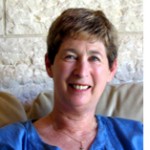By Dorothea Shefer-Vanson

MEVASSERET ZION, Israel — The windows of the upper floor of my house look out towards the hill in the Judaean Mountains known as the Castel, which is today the site of a national park. It is green in winter and grey-brown in summer. I love to paint the view, which is never the same throughout the year. The ruins of the castle which gives the summit its name once constituted the fortified stronghold that enabled the Crusaders to control the road from the coast to Jerusalem.
Originally the site of a Roman settlement known as Castellum, the building has long since been dismantled, leaving the blocks of stone strewn here and there on the hilltop. At one point it formed the site of an Arab village, also called Kastel, but most importantly, the Castel was the site of a crucial battle between Arab and Jewish forces in the War of Independence in 1948. A series of inscribed copper plaques affixed to the stones describes the course of the fighting. There is also a memorial for the Israeli soldiers who died there.
Because of its prominent position, when the site was in Arab hands the road to Jerusalem was virtually impassable. The burnt-out hulks of armored cars and troop-carriers that may still be seen as one travels to and from Jerusalem fell victim to the bombs and bullets of the Arab forces, leading to the deaths of many of the young fighters who were endeavouring to relieve the siege of Jerusalem at that time.
Because of its strategic significance, the hill was the object and site of a series of battles, and control of it changed hands several times in the course of the fighting in 1948. Ultimately, however, because the revered Arab commander Abd al-Qadir al-Husayni was killed in one such battle, most of the Arab fighters left their posts and went to Jerusalem to attend his funeral. This enabled the Israeli forces to take the Castel virtually unopposed that same day, in what has since become known as Operation Nachshon.
The suburb of Jerusalem that was built at the site in the 1950s to house new immigrants from North Africa, though officially called Ma’oz Zion, retained the name of Castel used by many of its inhabitants. In recent years it was officially merged with Mevasseret Yerushalayim to become Mevasseret Zion. All the same, perhaps as an act of defiance, some of the locals still call it the Castel.
But as I watch from my window I see a great swathe of concrete marring the line of the hill, fulfilling the need to add yet another, wider road connecting Israel’s inhabitants with one another, thus marking the inexorable march of ‘progress’ across the landscape.
*
Shefer-Vanson is a freelance writer and author, whose latest book, Time Out of Joint: The Fate of a Family, recently was reviewed on San Diego Jewish World. The author may be contacted via dorothea.shefer@sdjewishworld.com